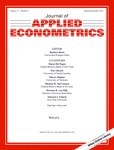
Koopman, S. and Luginbuhl, R. (2004). Convergence in European GDP Series Journal of Applied Econometrics, 19(5):611--636.
-
Affiliated author
-
Publication year2004
-
JournalJournal of Applied Econometrics
Convergence in the gross domestic product series of five European countries is empirically identified using multivariate time series models that are based on unobserved components with dynamic converging properties. We define convergence in terms of a decrease in dispersion over time and model this decrease via mechanisms that allow for gradual reductions in the ranks of covariance matrices associated with the disturbance vectors driving the unobserved components of the model. The inclusion of such convergence mechanisms within the formulation of unobserved components makes the identification of various types of convergence possible. The common converging component model is estimated for the per capita gross domestic product of five European countries: Germany, France, Italy, Spain and the Netherlands. It is found that convergence features in trends and cycles are present and are associated with some key events in the history of European integration. Copyright {\textcopyright} 2004 John Wiley & Sons, Ltd.